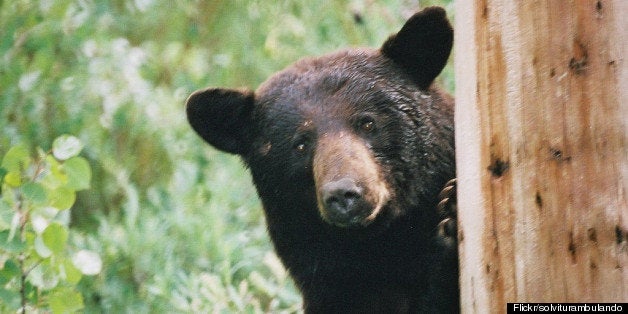
Barbara Jones and her family are accustomed to wildlife congregating in her yard, nestled in a heavily wooded area along Doctor Perry Road near Urbana.
Jones has a number of bird feeders, and deer and raccoons regularly stop by for a meal as well. But a new visitor has been snacking from her bird feeders and trash cans this week.
A large black bear has been spotted by neighbors and family members, she said.
"He's created a definite caution for us," Jones said.
Clarissa Harris, a biologist with the Department of Natural Resources' Wildlife and Heritage Service, said the black bear population in the region is healthy and growing, leading to sightings in places where bears would not have been found just a few years ago, such as southern Frederick County.
"It's that time of the year when young bears are out looking for food," Harris said. "Frederick County has become our new hot spot."
Harris estimated half a dozen reported sightings in the past few days in Frederick County alone.
A neighbor mentioned that a bear was seen in the area several weeks ago, but the family did not have its first encounter until granddaughter Laura Hickok caught a glimpse after she heard something rummaging through the trash cans below her bedroom window late Monday night.
"He turned his head because he heard me crack the window," Hickok said. "But by the time we got downstairs to look at the door, he had probably run back off into the woods."
The bear has returned each night since, the family said, leaving behind droppings, paw prints, empty birdseed bags, and overturned trash and recycling containers. The creature has also bent birdhouse poles and broken bird feeder hooks while looking for food. Hickok said she tried to catch a glimpse of the bear Tuesday evening. She didn't see him but said she heard him in the woods.
"He was just kind of lumbering through," she said. "I think he was waiting until the lights were off and the house was quiet before he was going to venture out."
Hickok has mixed feelings about having a bear so close to the house, she said, and the family plans to contact the Department of Natural Resources to see what can be done.
"I like animals and nature, so it's kind of cool that there's a bear, but also it's like, how early is he going to come out?" she said. "It's getting warm, and we like to be outside. And I don't want to be playing in the yard with my son and all of a sudden have a bear show up."
Eastern black bears are the least aggressive species of bear in the country and rarely pose a threat to humans, Harris said. They look for the easiest possible feeding opportunity, rarely preying on other mammals.
DNR seldom relocates bears, Harris said, adding that it typically happens only when they are in a heavy populated area or trapped in an environment they can't escape. On some occasions, officers will trap a bear, attempt to badly frighten the animal and release it, which usually spurs it to move on, she said.
The best way to get a bear to leave, she said, is to take away its food source by bringing bird feeders and trash cans inside at night. Frightening the bear with loud noises can also do the trick, she said.
"They're basically stomachs with legs who are always looking for where their next meal is coming from," she said.
___
(c)2013 The Frederick News-Post (Frederick, Md.)
Visit The Frederick News-Post (Frederick, Md.) at www.fredericknewspost.com
Distributed by MCT Information Services